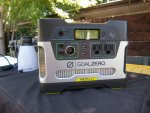The Yeti 400 would be used to:
- Keep the power topped up on 3 MacBook Pro's that we use for work/school on the road.
-Keep power topped up on 3 IPads
-run the stereo a few hours a day.
Sounds good.

What sort of stereo? Portable or bigger?
1) When I'm at a campground with power I plug in my power cord from the camper to the power source. This charges my batteries and allows me to use the 110V plugs in the camper for computers etc. If I set up the Yeti outside can O just plug my camper into it and expect to get the same result's? Use of 110V plugs and battery charging on camper.
Yes and no. You could probably run some lights and other light 110V use but that would be inefficient and you don't want the Yeti trying to charge your camper batteries. The Yeti 400 is better viewed as a self-contained and portable source... You can have computer charging, stereo, lighting, etc in the camper, OR outside the camper, OR in the truck, OR in someone elses truck, OR...
2)If we run the Yeti low can I leave it plugged to the camper and connect my generator to it to charge it faster?
Most definitely. You would charge with the power brick via 110V output at the generator for a max of about 70W. Goal Zero sells a splitter that allows up to 4 charging inputs So you could plug in the 110V charger AND solar AND a 12V car input. Max combined charge allowed is 120W.
NOTE: I use direct 12V car charging and pull over 120W through a single wire. You may find it better to charge via the truck than the genni.
3) Do I have to use goal Zero solar panels with it? I plan to buy just the power pack and get panels after.
I went for 2 years with no solar panels. You only really need if you want to camp for multidays and not run the vehicle/generator. You don't HAVE to use GZ panels but they do have a special connector that makes it easy. Using other panels usually requires making some adapters.
4) What is the largest panel I can use for quickest charging?
I've been hesitant for a long time about Solar as we are a family of 4 working on the road and road schooling a 10yr old. We consume some power!
Thanks,
Yeti400 maxes out at 120W charging regardless of source.
You have to analyze your exact scenario to understand what benefits you can get from solar. You have a big camper that probably already has a couple of big batteries. If you usually camp in areas where the camper is in the sun then roof mounted panels make a lot of sense.
The Yeti 400 is a really good tool but for your needs you may be better to add a solar controller to your existing camper batteries. Something like this
http://smile.amazon.com/gp/product/B005LBCVL4?keywords=Ctek dual&qid=1444925519&ref_=sr_1_1&sr=8-1 allows that. Combined with some USB outlets and you could have a built-in system in the camper that achieves a lot of what a Yeti400 does while maintaining all the normal "camper" conveniences.
On the other hand... If you are willing to use the Yeti400 just for charging devices and laptops and running some LED lights or other 12v items then I think it could serve you well. Just be realistic.



